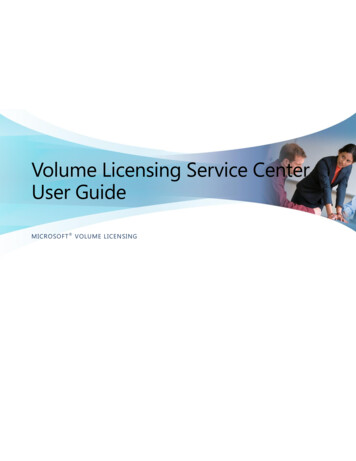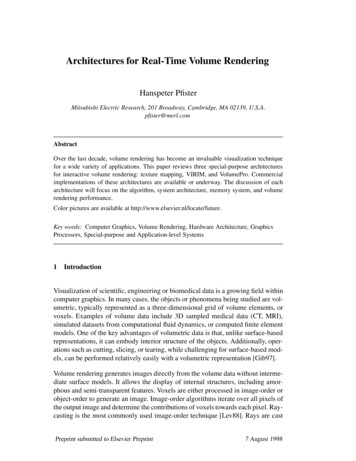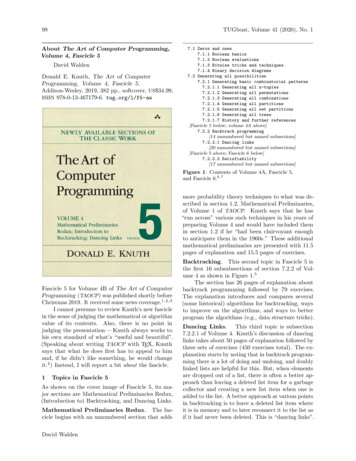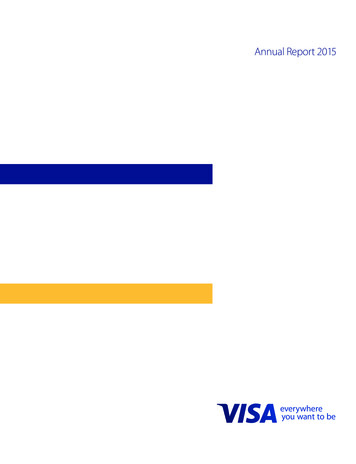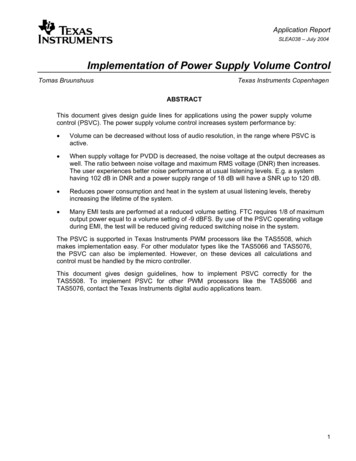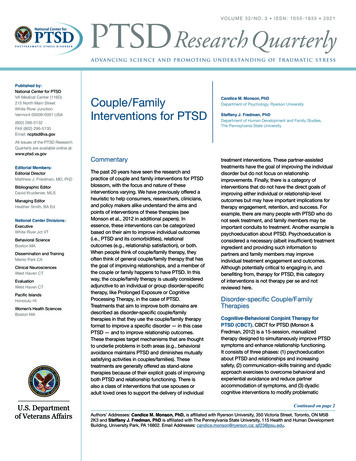
Transcription
V O L U M E 3 2 / N O . 3 I S S N : 1 0 5 0 -1 8 3 5 2 0 2 1Research Quarterlyadvancing science and pr omoting unders tanding of traum atic stressPublished by:National Center for PTSDVA Medical Center (116D)215 North Main StreetWhite River JunctionVermont 05009-0001 USA(802) 296-5132FAX (802) 296-5135Email: ncptsd@va.govAll issues of the PTSD ResearchQuarterly are available online at:www.ptsd.va.govEditorial Members:Editorial DirectorMatthew J. Friedman, MD, PhDBibliographic EditorDavid Kruidenier, MLSManaging EditorHeather Smith, BA EdNational Center Divisions:ExecutiveWhite River Jct VTBehavioral ScienceBoston MADissemination and TrainingMenlo Park CAClinical NeurosciencesWest Haven CTEvaluationWest Haven CTPacific IslandsHonolulu HIWomen’s Health SciencesBoston MACouple/FamilyInterventions for PTSDCandice M. Monson, PhDDepartment of Psychology, Ryerson UniversityCommentarytreatment interventions. These partner-assistedtreatments have the goal of improving the individualdisorder but do not focus on relationshipimprovements. Finally, there is a category ofinterventions that do not have the direct goals ofimproving either individual or relationship-leveloutcomes but may have important implications fortherapy engagement, retention, and success. Forexample, there are many people with PTSD who donot seek treatment, and family members may beimportant conduits to treatment. Another example ispsychoeducation about PTSD. Psychoeducation isconsidered a necessary (albeit insufficient) treatmentingredient and providing such information topartners and family members may improveindividual treatment engagement and outcomes.Although potentially critical to engaging in, andbenefiting from, therapy for PTSD, this categoryof interventions is not therapy per se and notreviewed here.The past 20 years have seen the research andpractice of couple and family interventions for PTSDblossom, with the focus and nature of theseinterventions varying. We have previously offered aheuristic to help consumers, researchers, clinicians,and policy makers alike understand the aims andpoints of interventions of these therapies (seeMonson et al., 2012 in additional papers). Inessence, these interventions can be categorizedbased on their aim to improve individual outcomes(i.e., PTSD and its comorbidities), relationaloutcomes (e.g., relationship satisfaction), or both.When people think of couple/family therapy, theyoften think of general couple/family therapy that hasthe goal of improving relationships, and a member ofthe couple or family happens to have PTSD. In thisway, the couple/family therapy is usually consideredadjunctive to an individual or group disorder-specifictherapy, like Prolonged Exposure or CognitiveProcessing Therapy, in the case of PTSD.Treatments that aim to improve both domains aredescribed as disorder-specific couple/familytherapies in that they use the couple/family therapyformat to improve a specific disorder — in this casePTSD — and to improve relationship outcomes.These therapies target mechanisms that are thoughtto underlie problems in both areas (e.g., behavioralavoidance maintains PTSD and diminishes mutuallysatisfying activities in couples/families). Thesetreatments are generally offered as stand-alonetherapies because of their explicit goals of improvingboth PTSD and relationship functioning. There isalso a class of interventions that use spouses oradult loved ones to support the delivery of individualSteffany J. Fredman, PhDDepartment of Human Development and Family Studies,The Pennsylvania State UniversityDisorder-specific Couple/FamilyTherapiesCognitive-Behavioral Conjoint Therapy forPTSD (CBCT). CBCT for PTSD (Monson &Fredman, 2012) is a 15-session, manualizedtherapy designed to simultaneously improve PTSDsymptoms and enhance relationship functioning.It consists of three phases: (1) psychoeducationabout PTSD and relationships and increasingsafety, (2) communication-skills training and dyadicapproach exercises to overcome behavioral andexperiential avoidance and reduce partneraccommodation of symptoms, and (3) dyadiccognitive interventions to modify problematicContinued on page 2Authors’ Addresses: Candice M. Monson, PhD, is affiliated with Ryerson University, 350 Victoria Street, Toronto, ON M5B2K3 and Steffany J. Fredman, PhD is affiliated with The Pennsylvania State University, 115 Health and Human DevelopmentBuilding, University Park, PA 16802. Email Addresses: candice.monson@ryerson.ca; sjf23@psu.edu.
Continued from covertrauma appraisals and maladaptive beliefs that can maintain PTSDand relationship problems. Liebman and colleagues (2020) havepublished a systematic review on the primary and secondaryoutcomes of CBCT. Highlights are included here.Three uncontrolled studies with Vietnam Veterans (Monson et al.,2004), Iraq and Afghanistan Veterans (Schumm et al., 2015), andcommunity members (Monson et al., 2011) and their intimatepartners demonstrate improvements in PTSD symptoms andrelationship functioning in couples who may or may not be clinicallydistressed at the outset of therapy.Regarding adjunctive treatment with the psychoactive drug3,4-Methylenedioxy methamphetamine (MDMA), commonly knownas ecstasy, Monson and colleagues (2020) recently published asmall uncontrolled trial of MDMA-facilitated CBCT. This trial waspursued based on the empathogenic qualities of MDMA and itspromise to potentiate a relationally-oriented treatment for PTSD, aswell as successful use of it with an individual therapy for PTSD. Thisstudy provides initial evidence of its safety and potential efficacy inenhancing treatment outcomes. More specifically, the pre-treatmentto 6-month follow-up effects for PTSD and relationship adjustmentwere larger than that found in prior CBCT and individual evidencebased treatment trials (e.g., d 3.79 for patient-rated PTSD;d 2.59 for patient-rated relationship satisfaction (Monson et al.,2020). Further controlled trials are needed to examine the potentialof MDMA to facilitate CBCT.A randomized controlled trial of CBCT was completed with asample of individuals with a range of traumatic events and couplecharacteristics (i.e., community, Veteran, married, cohabitating,non-cohabitating, mixed gender, same sex; Monson et al., 2012).In this trial, there were significant improvements in PTSD andcomorbid symptoms among patients who received CBCT forPTSD relative to those on a waiting list, with treatment effects onpar with those found in individual evidence-based treatment forPTSD. Patients, but not partners, also reported significantimprovements in relationship adjustment.Pukay-Martin et al. (2015) investigated a present-centered versionof CBCT for PTSD in a sample of seven community couples. Thisadapted version of CBCT included: (1) psychoeducation and safetybuilding, (2) behavioral strategies to enhance relationshipsatisfaction and improve communication, and (3) cognitiveinterventions to address here-and-now maladaptive thoughts butno direct historical reappraisals of the trauma itself. There weresignificant and medium-to-large decreases in patients’ PTSDsymptoms, as well as significant and medium effect sizeimprovements in partners’ relationship satisfaction andaccommodation of patients’ PTSD symptoms. This version ofCBCT for PTSD may be a viable alternative for patients or dyadswho are not willing to engage in a trauma-focused treatment.To increase treatment efficiency and scalability, Fredman et al.(2020) tested an abbreviated, intensive, multi-couple groupversion of CBCT (AIM-CBCT) in a sample of 24 couples whoincluded an United States (US) active duty service member orVeteran who had served in the post-9/11 conflict and wasdiagnosed with PTSD. Treatment consisted of the first 7 sessionsof CBCT delivered over a single weekend in a retreat format togroups consisting of two to six couples at a time. All 24 couplesPAGE 2completed treatment. By the 3-month follow-up assessment,there were significant and large reductions in patients’ PTSD andsignificant and moderate or moderate-to-large reductions incomorbid depressive, anxiety, and anger symptoms. There werealso significant improvements in partners’ perceptions of patients’PTSD symptoms and in their own depressive and anxietysymptoms and relationship satisfaction.Davis and colleagues (2021) have also developed a modifiedversion of CBCT that integrates mindfulness-based practices and acombination of retreats and couple sessions (MB-CBCT). In arandomized clinical trial (RCT) of 46 US Iraq and AfghanistanVeterans with PTSD, the authors compared two versions of CBCT.MB-CBCT included the first two phases of CBCT delivered in amulti-couple group retreat and then followed by 9 sessions ofCBCT for PTSD Phase 3 delivered to individual couples. The otherversion was a modified version of CBCT that included training incommunication skills from phases 1 and 2 of CBCT but withoutPTSD-specific content (CBCT-CS). CBCT-CS was also delivered ina multi-couple group retreat. The CBCT-CS group subsequentlyreceived two monthly post-retreat group sessions that reviewedcommunication skills. There were medium-to-large within-grouppre-to-post improvements in Veterans’ clinician-rated PTSDsymptoms, Veterans’ relationship adjustment, and partners’relationship adjustment for both MB-CBCT and CBCT-CS, but nodifferences between the two active treatments.Couple Treatment for Addiction and PTSD (CTAP). CTAP is a15-session integration of CBCT (Monson & Fredman, 2012) andbehavioral couple therapy for substance use disorders (O’Farrell &Fals-Stewart, 2006). Schumm et al. (2015) tested CTAP in anuncontrolled study of nine US Veterans with PTSD and theirintimate partners. In this trial, significant reductions in clinicianrated, Veteran-rated, and partner-rated PTSD severity were found.There were also significant decreases in Veterans’ days of heavydrinking. However, there were no significant changes in eitherpartners’ relationship adjustment.Structured Approach Therapy (SAT). SAT is a 10-12 sessionmanualized couple therapy for PTSD that consists ofpsychoeducation about PTSD and strategies for enhancingmotivation for treatment and behavioral skills for couples toreinforce each other’s positive emotions and intimacy. Partnersare also coached to provide assistance to patients in approachingand tolerating feared stimuli. Finally, the treatment includescouple-based discussions about the traumatic event(s) andassociated thoughts, feelings, and memories about it that may bedistressing to the patient or cause stress within the relationship(Sautter et al., 2015).An uncontrolled trial of SAT with six male US Vietnam-era combatVeterans and their female partners who completed a 10-sessionversion of the intervention demonstrated significant improvementsin total PTSD symptoms according to patient, partner, and clinicianratings. However, when clinician-assessed symptom clusters wereexamined, there were changes in emotional numbing andavoidance symptoms but not in reexperiencing or hyperarousalsymptoms (Sautter et al., 2009). In a subsequent study of sevenmale US Iraq/Afghanistan Veterans and their wives, there weresimilarly significant reductions in both self- and clinician-relatedPTSD symptoms but no improvements in relationship adjustmentP T S D R E S E A R C H Q U A R T E R LY
for either partner (Sautter et al., 2014). However, 7 of 9 participantswho were relationally distressed at pre-treatment exhibited clinicallysignificant improvements in relationship adjustment.A randomized controlled trial comparing SAT to Patient and FamilyEducation (PFE) with US Iraq/Afghanistan Veterans with PTSD andtheir intimate partners found SAT superior to PFE in clinician-ratedand self-reported PTSD symptoms at post-treatment and follow-up(Sautter et al., 2015). Veterans receiving SAT reported significantimprovements in their relationship adjustment and attachmentavoidance compared with those who received PFE.Emotionally Focused Couple Therapy (EFCT). EFCT isdescribed as an experiential intervention that focuses onunderstanding and processing emotions that are connected totraumatic experiences and broader attachment behaviors thataffect relational processes and communication (Johnson, 2005).EFCT is divided into three main stages that focus on: (1) stabilizingthe couple through the assessment, identification, and sharing ofnegative interaction patterns, (2) building relational skills in thecouple through acceptance and communication, and (3) integratingtherapeutic gains by developing coping strategies and healthierinteraction patterns.Three published studies (one waitlist RCT) document variablePTSD and relationship outcomes. The variation in these findingsmay be related to the different inclusion criteria used in thesestudies. The first study providing initial support for EFCT within atraumatized sample was a study of 10 mixed gender couples thatincluded a woman with a history of childhood sexual abuse(Macintosh & Johnson, 2008). The authors report that allparticipants improved at least a standard deviation in clinicianrated PTSD symptoms and that half self-reported clinicallysignificant improvements in PTSD. One-half self-reported clinicallysignificant improvements in relationship satisfaction, but threecouples experienced decreased satisfaction and increasedemotional abuse and terminated their relationships during thecourse of therapy.Another uncontrolled study of EFCT included 15 US Veterans withPTSD and their intimate partners (Weissman et al., 2018). Thestudy had more than a 50% drop-out from treatment (andassessment), and the authors consequently reported results ontreatment completers. Among those who completed treatment,there were no significant improvements in Veterans’ clinician-ratedPTSD but there were significant improvements in self-reportedPTSD. Partners experienced significant improvements inrelationship satisfaction.A waitlist controlled RCT tested EFCT for distressed mixed gendercouples that included women with a history of childhood physicalor sexual abuse (did not establish PTSD diagnosis or use asinclusion criteria; Dalton et al., 2013). There was no dropout in theimmediate treatment group, and there were significantimprovements in relationship adjustment among those in theimmediate treatment group relative to those in the delayedtreatment group. There were no significant improvements intrauma-related symptoms as measured with the Trauma SymptomInventory (TSI; Briere, 1995) and Dissociative Experiences Scale(Bernstein & Putnam, 1986) between the two conditions. SpecificPTSD symptoms outcomes were not reported.VOLUME 32/NO. 3 2021General Couple/Family TherapiesBehavioral Couple/Family Therapy (BC/FT). BC/FT is grounded inbehavioral conceptualizations of couple/family distress that hold thatthe lack of reinforcing interactions, as well as aversive, conflict-ladeninteractions, lead to distress. Following from this, BC/FT generallyinvolves behavioral exercises to increase positive, reinforcingexchanges in couples and families, and communication skillstraining. BCT is well-established in improving couple and familydistress across various samples. Specific to PTSD samples, twocompleted RCTs have documented the efficacy of BC/FT in samplesof US Veterans and their family members in improving relationshipsatisfaction but not PTSD symptoms. One was a small dissertationstudy of group BCT compared with waitlist (Sweany, 1987), and theother was a larger study that added BFT after individual exposuretherapy (Glynn et al., 1999). There have been other uncontrolledtrials/program evaluation studies that included BC/FT interventionsdocumenting improvements in relationship outcomes. These includeCahoon’s dissertation (1984), the K’oach Program (Solomon et al.,1992), and the REACH Program (Fischer et al., 2013).Partner-assisted TherapiesWe are aware of only one partner-assisted intervention that has beentested that has included intimate partners in treatment to improveindividual PTSD outcomes. Devilly (2002) describes programevaluation results from a Lifestyle Management Course provided toAustralian combat Veterans and their partners. This course was anintensive week-long residential group intervention that includedPTSD psychoeducation and symptom management techniques.At follow-up, Veterans reported a significant reduction in PTSDsymptoms, and both Veterans and their partners reported significantreductions in anxiety, depression, and general stress. There were noimprovements in relationship satisfaction.SummaryThere is growing recognition of the larger interpersonal context inwhich PTSD is situated and the interpersonal relationship problemsthat co-occur with it. As reviewed, there is the most support fordisorder-specific therapies for improving PTSD and relationshipfunctioning, and some evidence for other strategies for improvingPTSD or relationship outcomes (but not both). We expect that otherinnovative techniques will emerge such as other partner-assistedinterventions that might facilitate individual evidence-basedtreatments (e.g., see Thompson-Hollands et al., 2021in additionalarticles), the use of other evidence-based general couple therapieslike Integrative Behavioral Couple Therapy (Christensen et al., 2020),and partner-only interventions to improve the health and well-beingof loved ones. We also expect that massed dosing (e.g., retreatstudies above) and technology will continue to be harnessed toovercome some of the burdens and barriers of traditional officedelivered psychotherapy, especially for couples and families. Forexample, Morland and colleagues (2019; see additional articles) willsoon be unblinding the results of their trial comparing in-office CBCTfor PTSD, home-based CBCT for PTSD delivered via secure video,and Patient Family Psychoeducation control in a large sample of USVeterans with PTSD and their intimate partners. Monson andcolleagues (2021; see additional articles) have recently developed anonline, guided self-help intervention drawing from CBCT for PTSD,Couple HOPES (www.couplehopes.com), which is designed to be anPAGE 3
alternative offering in the spectrum of interventions. We are delightedthat institutions like the US Department of Veterans Affairs (VA) havechosen to systematically disseminate various couple/family therapiesfor those with PTSD, recognizing the importance of theserelationships and the loved ones in them. We look forward to seeingwhat the next generation of research and practice in the area hold.Featured ArticlesCahoon, E. P. (1984). An examination of relationships betweenpost-traumatic stress disorder, marital distress, and response totherapy by Vietnam veterans. Unpublished doctoral dissertation,University of Connecticut, Storrs. 6066 Diagnosis and treatment of PTSD inVietnam Veterans has become an important clinical and social issue.Using a sample of 60 combat Veterans and partners, this studyexamined (1) the validity of current measures of PTSD; (2) the role ofmarital distress in severity of PTSD; (3) the effects of rap grouptreatment on the marital relationship; (4) attitudes toward conjointtreatment; and (5) the effects of couples group therapy in reducingmarital dissatisfaction in severely distressed Veterans. The resultslent support to the Vietnam Era Stress Inventory as a valid self-reportmeasure of stress symptoms. Severity of PTSD was found tocorrelate highly with standardized measures of anxiety and maritaldistress according to Veterans’ and spouses’ reports. PTSD scoresalso correlated highly with behavioral ratings by rap groupcounselors. Multiple Regression Analyses showed marital factors tobe significant predictors of severity of PTSD. This studyhypothesized treatment-specific effects for the rap group in anxiety,but nongeneralizable effects to the marriage. Neither reductions inthe high levels of anxiety or the extent of dissatisfaction with themarriage were correlated significantly with length of time in rapgroup therapy. Spouses reported themselves to be more willing toparticipate in conjoint treatment than their patterns. Higher levels ofPTSD correlated with preferences for separate treatment forVeterans and wives. Contrary to statements of willingness, fewcouples were actually willing to commit themselves to conjointtherapy groups. Veterans who did agree had higher PTSD andanxiety scores than the general sample, a finding contrary to generalpsychotherapy outcome research. Results of the Marital SatisfactionInventory indicated affective and problem-solving communication tobe central areas of concern for Veterans and partners. A seven-weekcouples group, focusing on basic communication skills, wasassessed. Improvements were seen in global satisfaction andcommunication. Generalizations beyond the marital system includedspouse observations of lower anxiety and rap group counselorratings of increased ability to cope with stress and fewer PTSDsymptoms. The inclusion of a conjoint component in the treatment ofPTSD was strongly recommended.Dalton, E. J., Greenman, P. S., Classen, C. C., & Johnson, S. M.(2013). Nurturing connections in the aftermath of childhoodtrauma: A randomized controlled trial of emotionally focusedcouple therapy for female survivors of childhood abuse. Coupleand Family Psychology: Research and Practice, 2, 209–221.doi:10.1037/a0032772 Emotionally focused therapy (EFT) forcouples is an empirically supported treatment for relationshipdistress (Johnson and Greenberg Journal of Consulting and ClinicalPsychology 1985a;53:175–184; Johnson, The practice ofPAGE 4emotionally focused marital therapy: Creating connection. NewYork: Brunner-Routledge, 2004). Despite strong evidence of a linkbetween experiences of childhood abuse and problems in intimaterelationships during adulthood (Paradis and Boucher, Journal ofAggression, Maltreatment & Trauma 2010;19:138–158; Walker etal., Journal of Family Violence 2009;24:397–406), there have notyet been any controlled trials of the efficacy of EFT for adultsurvivors of childhood abuse. In light of evidence of theeffectiveness of individual EFT in the treatment of the sequelae ofcomplex trauma (Paivio and Pascual-Leone, Emotion-focusedtherapy for complex trauma: An integrative approach. Washington,DC: American Psychological Association, 2010), we conducted thefirst randomized controlled trial of EFT for couples in which thefemale partner had a history of intrafamilial childhood abuse. Ourprimary hypothesis was that couples treated with EFT wouldexperience a significant reduction in relationship distress. To testthis hypothesis, 24 couples in Toronto, Ontario, Canada (meanrelationship length 14 years), were randomly assigned to either atreatment group (24 sessions of EFT) or a control group (waitinglist). Analyses of covariance with treatment condition as the fixedfactor and baseline scores on the Dyadic Adjustment Scale(Spanier, Journal of Marriage and the Family 1976;38:15–28) as thecovariate yielded a statistically significant effect of treatment groupon relationship distress. Hierarchical regression analyses unveiledthe particular circumstances under which EFT appeared to beeffective. These results attest to the effectiveness of EFT forrelational distress in trauma survivors and are discussed in light ofthe relevant clinical literature.Davis, L. W., Luedtke, B. L., Monson, C. M., Siegel, A., Daggy, J. K.,Yang, Z., Bair, M. J., Brustuen, B., & Ertle, M. (2021). Testingadaptations of Cognitive-Behavioral Conjoint Therapy for PTSD:A randomized controlled pilot study with veterans. Couple andFamily Psychology: Research and Practice, 10, (2), 71–86.doi:10.1037/cfp0000148 Iraq and Afghanistan Veterans with PTSDhave well-documented relationship problems and many wish toinclude their intimate partners in treatment. This pilot study randomlyassigned 46 couples (Veterans with clinician-administered PTSDscale confirmed PTSD diagnosis and their intimate partners) to oneof two groups. The treatment group received a modifiedmindfulness-based version of CBCT for PTSD (CBCT; Monson &Fredman, 2012) that included all three phases of the mindfulnessbased cognitive behavioral conjoint therapy (MB-CBCT). The controlgroup received a modified version of CBCT that includedcommunication skills training from Phases 1 and 2 of CBCT(CBCT-CS) without PTSD-specific content. Modified CBCT Phases 1and 2 content was delivered to both groups during weekend retreatsin multicouple group sessions. The postretreat protocol for MBCBCT included nine individual couple sessions: a transition sessionfollowing the retreat, and CBCT Phase 3. For CBCT-CS, twoadditional monthly multicouple group sessions reviewedcommunication skills. No statistically significant pre- toposttreatment differences were detected for primary outcomesbetween groups: Clinician-Administered PTSD Scale for Veterans(mean change difference, 1.4, 95% CI [ 16.0 to 13.2]); DyadicAdjustment Scale for Veterans (mean change difference, 1.0, 95%CI [ 13.2 to 11.2]); and Dyadic Adjustment Scale for Partners (meanchange difference, 0.4, 95% CI [ 8.9 to 8.1]). However, withingroup pre- to posttreatment effect sizes were medium to large forP T S D R E S E A R C H Q U A R T E R LY
FEATURED ARTICLES continuedboth MB-CBCT and CBCT-CS on all three primary outcomes.Findings suggest that Veterans returning from recent conflicts andtheir partners may benefit from both modifications of CBCT.Devilly, G. J. (2002). The psychological effects of a lifestylemanagement course on war veterans and their spouses. Journalof Clinical Psychology, 58, 1119–1134. doi:10.1002/jclp.10041 Thisresearch assessed the effect on a war-Veteran outpatient group in aweek-long residential lifestyle-management course. This course alsoincluded the Veterans’ partners, and all participants were assessedat intake, post-intervention, and at three- and six-month follow-ups.In summary, it was found that while there was a statisticallysignificant drop in PTSD symptomatology for the Veterans, theclinical utility of this improvement was minimal, with an estimatedeffect size of d 0.19 by six-month follow-up. However, the Veteransdisplayed a significant decrease in measures of depression, anxiety,and stress by six-month follow-up, all with small-to-moderate effectsizes. Likewise, ratings of anger showed statistically significantimprovement with a moderate effect size. While dyadic adjustmentdisplayed a significant improvement to six-month follow-up, thederived effect size was small for the Veterans. The spouses (allfemales in this study) displayed larger effect sizes on all measures,with the exception of ratings of anger, where a small effect wasnoted. Subjective quality-of-life indices displayed a significantchange in the desired direction, although with a minimal effect forthe Veterans and a small effect size for the females. It was notfeasible to have a control group during this naturalistic investigationand, therefore, caution is advised in over-generalizing from thesedata. However, these results warrant further ‘controlled’ investigationinto the inclusion of spouses in the treatment of Veterans and theutility of lifestyle-management courses as a first step in the treatmentof trauma related problems that have become chronic in naturewithin the Veteran community.Fredman, S. J., Macdonald, A., Monson, C. M., Dondanville, K. A.,Blount, T. H., Hall-Clark, B. N., Fina, B. A., Mintz, J., Litz, B. T.,Young-McCaughan, S., Hancock, A. K., Rhoades, G. K., Yarvis, J. S.,Resick, P. A., Roache, J. D., Le, Y., Wachen, J. S., Niles, B. L.,McGeary, C. A., Keane, T. M., & Peterson, A. L., for the Consortiumto Alleviate PTSD (2020). Intensive, multi-couple group therapy forPTSD: A nonrandomized pilot study with military and veterandyads. Behavior Therapy, 51, 700–714. doi:10.1016/j.beth.2019.10.003 CBCT for PTSD (Monson & Fredman, 2012) isefficacious in improving PTSD symptoms and relationshipadjustment among couples with PTSD. However, there is a need formore efficient delivery formats to maximize engagement andretention and to achieve faster outcomes in multiple domains. Thisnonrandomized trial was designed to pilot an abbreviated, intensive,multi-couple group version of CBCT for PTSD (AIM-CBCT for PTSD)delivered over a single weekend for 24 couples that included anactive-duty service member or Veteran with PTSD who haddeployed in support of combat operations following September 11,2001. All couples completed treatment. Assessments conducted byclinical evaluators 1 and 3 months after the intervention revealedsignificant reductions in clinician-rated PTSD symptoms (ds -0.77and -0.98, respectively) and in patients’ self-reported symptoms ofPTSD (ds -0.73 and -1.17, respectively), depression (ds -0.60and -0.75, respectively), anxiety (ds -0.63 and -0.73, respectively),VOLUME 32/NO. 3 2021and anger (ds -0.45 and -0.60, respectively), relative to baseline.By 3-month follow-up, partners reported significant reductions inpatients’ PTSD symptoms (d -0.56), as well as significantimprovements in their own depressive symptoms (d -0.47), anxiety(d -0.60), and relationship satisfaction (d 0.53), relative tobaseline. Delivering CBCT for PTSD through an abbreviated,intensive multi-couple group format may be an efficient strategy forimproving patient, partner, and relational well-being in military andVeteran couples with PTSD.Glynn, S. M., Eth, S., Randolph, E. T., Foy, D. W., Urbaitis, M., Boxer,L., Paz, G. G., Leong, G. B., Firman, G., Salk, J. D., Katzman, J. W.,& Crothers, J. (1999). A test of behavioral family therapy toaugment exposure for combat-related posttraumatic stressdisorder. Journal of Consulting and Clinical Psychology, 67,243–251. doi:10.1037/0022-006X.67.2.243 This study tested afamily-based skills-building intervention in Veterans with chroniccombat-related PTSD. Veterans and a family member were randomlyassigned to 1 of 3 conditions: (a) waiting list, (b) 18 sess
Structured Approach Therapy (SAT). SAT is a 10-12 session manualized couple therapy for PTSD that consists of psychoeducation about PTSD and strategies for enhancing motivation for treatment and behavioral skills for couples to reinfo





